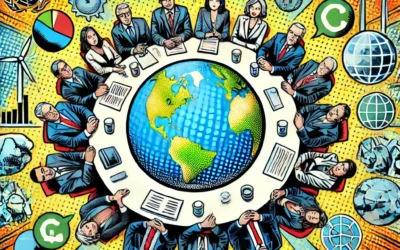Air and Climate: Carbon Emissions 2050
Carbon emissions are the main cause of global warming and climate change. They come from burning fossil fuels, such as coal, oil, and gas, for energy, transport, industry, and other activities. To limit the global temperature rise to 1.5°C, as agreed in the Paris Agreement, carbon emissions need to reach net zero by 2050. This means that any remaining emissions are balanced by removing carbon from the atmosphere. How can we achieve this ambitious goal, and what are the benefits and challenges of doing so?
The current situation and the gap to net zero
According to the IEA, global carbon emissions from the energy sector reached a record high of 33.4 gigatons (Gt) in 2019, after two years of growth. The COVID-19 pandemic caused a temporary drop of 5.8% in 2020, but emissions rebounded quickly in 2021, surpassing the 2019 level by 1.5%. The main drivers of the emissions increase were the recovery of economic activity, the surge in coal demand, and the insufficient deployment of clean energy technologies.
The IEA also estimated that the current policies and pledges by governments would result in carbon emissions of 22 Gt by 2050, which is far from the net zero target. To close this gap, the IEA proposed a Net Zero Emissions by 2050 (NZE) scenario, which outlines a pathway for the global energy sector to reach net zero by 2050, while ensuring energy security, affordability, and access. The NZE scenario requires a radical transformation of the energy system, with unprecedented levels of cooperation, innovation, and investment.
The key actions and milestones to net zero
The NZE scenario identifies four key pillars for achieving net zero by 2050: energy efficiency, renewable energy, electrification, and innovation. It also sets out some key milestones for each pillar, as follows:
Energy efficiency: Improving energy efficiency is the most cost-effective and immediate way to reduce carbon emissions. It means using less energy to provide the same or better services, such as lighting, heating, cooling, and mobility. The NZE scenario calls for a tripling of the annual energy efficiency improvement rate, from 1.6% in 2020 to 4.6% in 2030. It also calls for halting the sales of new fossil fuel boilers by 2025, and new internal combustion engine cars by 2035.
Renewable energy: Increasing the share of renewable energy is the main way to decarbonize the energy supply. It means using more energy from natural sources, such as solar, wind, hydro, geothermal, and bioenergy. The NZE scenario calls for a quadrupling of the annual renewable capacity additions, from 280 gigawatts (GW) in 2020 to over 1,000 GW in 2030. It also calls for phasing out all unabated coal-fired power plants by 2040, and all unabated gas-fired power plants by 2050.
Electrification: Expanding the use of electricity is the main way to decarbonize the energy demand. It means using more electricity for end-use sectors, such as transport, buildings, and industry, instead of fossil fuels. The NZE scenario calls for a doubling of the annual electric vehicle sales, from 3 million in 2020 to 6 million in 2021, and reaching over 50% of the global car fleet by 2030. It also calls for increasing the share of electricity in the total final energy consumption, from 20% in 2020 to 49% in 2050.
Innovation: Accelerating the development and deployment of low-carbon technologies is the main way to overcome the barriers and uncertainties to net zero. It means using more technologies that are not yet commercially available or widely adopted, such as hydrogen, carbon capture, utilization and storage (CCUS), and direct air capture (DAC). The NZE scenario calls for increasing the public spending on clean energy research and development, from $25 billion in 2020 to $90 billion in 2030. It also calls for deploying 390 Mt of CCUS and 150 Mt of DAC by 2050.
The benefits and challenges of net zero
Reaching net zero by 2050 is not only necessary to avoid the worst impacts of climate change, but also beneficial for human health, well-being, and prosperity. According to the IEA, the NZE scenario would prevent 2.5 million premature deaths from air pollution every year, compared to the current policies scenario. It would also create 30 million additional jobs in clean energy and related sectors, and increase the global GDP by 4% by 2050, compared to the current policies scenario.
Reaching net zero by 2050 would also contribute to the achievement of the Sustainable Development Goals (SDGs), a set of 17 global goals that aim to end poverty, protect the planet, and ensure peace and prosperity for all by 2030. For example, reaching net zero by 2050 would help to end hunger and malnutrition, by improving food security and resilience. It would also help to ensure health and well-being, by reducing the exposure to air pollution and extreme weather events.
It would also help to provide clean and affordable energy, by expanding the access to renewable sources. It would also help to foster innovation and economic growth, by stimulating the development and diffusion of low-carbon technologies.
However, reaching net zero by 2050 also poses significant challenges and trade-offs, such as:
- The need for unprecedented levels of cooperation and coordination among governments, businesses, civil society, and consumers, at local, national, regional, and global levels. This requires strong political will, clear policy signals, effective governance mechanisms, and inclusive stakeholder engagement.
- The need for massive and sustained investments in clean energy and infrastructure, as well as the phase-out of fossil fuel subsidies and assets. This requires mobilizing and reallocating financial resources, creating enabling environments, managing risks and uncertainties, and ensuring a just transition for workers and communities.
- The need for rapid and widespread behavioral and lifestyle changes, such as reducing energy demand, switching to low-carbon modes of transport, adopting plant-based diets, and embracing circular economy principles. This requires raising awareness, providing incentives, removing barriers, and empowering consumers.
Conclusion
Carbon emissions are the main cause of global warming and climate change, and they need to reach net zero by 2050 to limit the global temperature rise to 1.5°C. This requires a radical transformation of the energy system, with four key pillars: energy efficiency, renewable energy, electrification, and innovation.
Achieving net zero by 2050 is not only necessary, but also beneficial, as it would improve human health, well-being, and prosperity, as well as contribute to the Sustainable Development Goals. However, achieving net zero by 2050 also poses significant challenges and trade-offs, such as the need for unprecedented levels of cooperation, investment, and behavioral change. The net zero global target is therefore the most urgent and ambitious goal of the global community, and it requires the collective action and commitment of all stakeholders.
Learn more:






